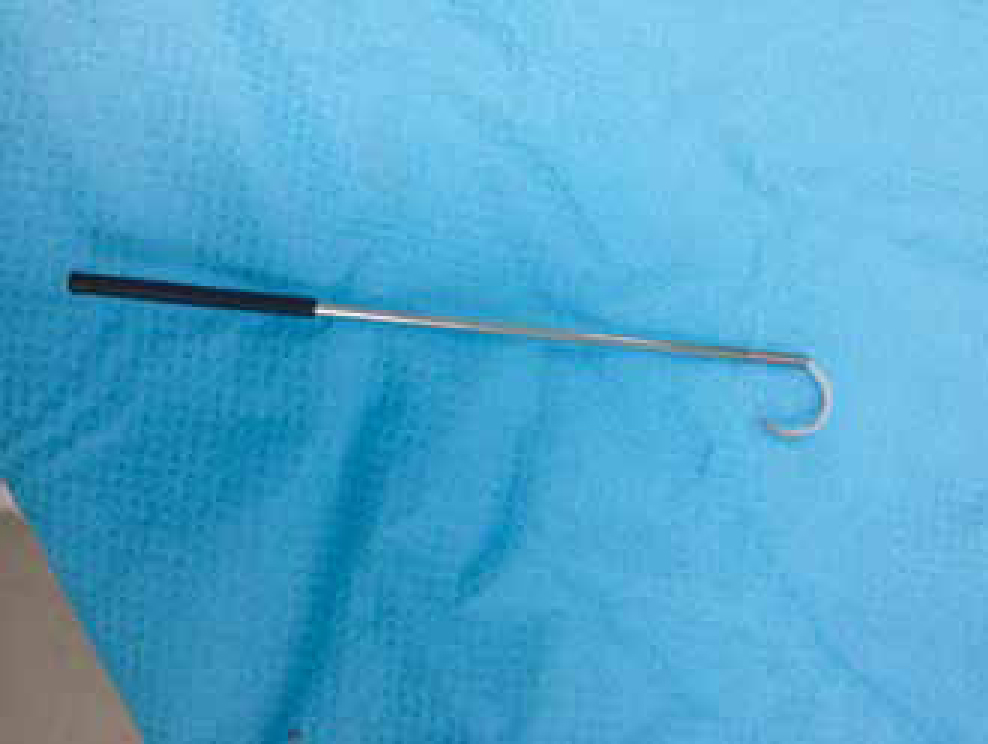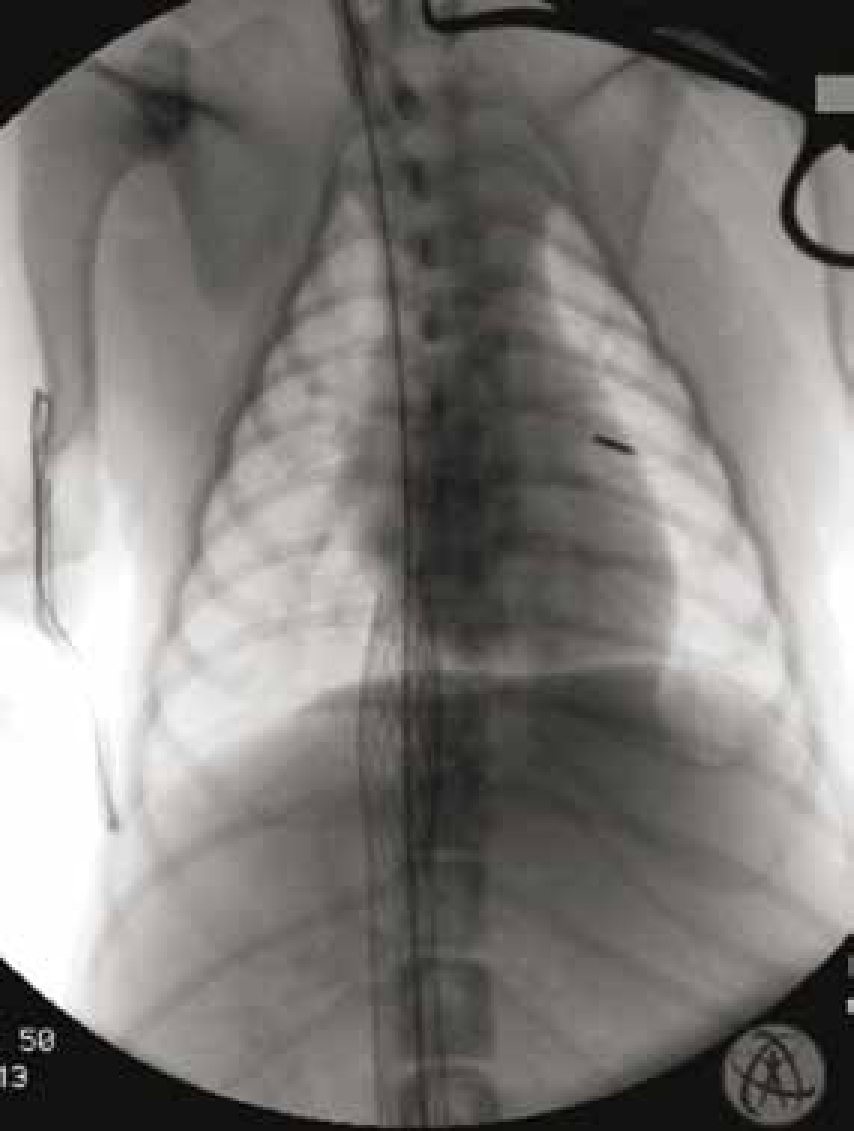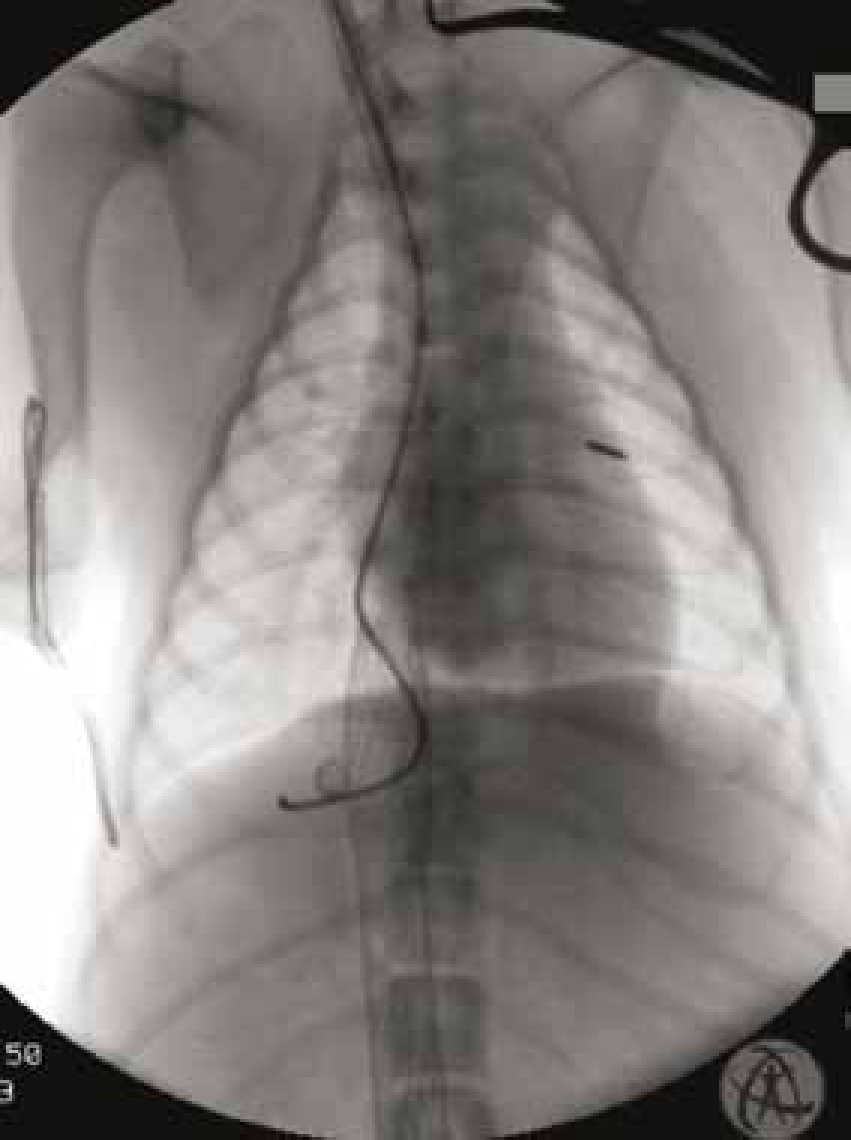Portosystemic shunts (PSS) are defined as vessels that allow portal blood to drain from the stomach, intestines, pancreas and spleen directly into the systemic circulation thus bypassing the liver (Fossum, 2007). They can be extrahepatic, occurring outside of the hepatic system, or intrahepatic, occurring within the hepatic portal system. It is the surgical treatment of intrahepatic portosystemic shunts (IHPSS), mainly occlusion of the shunting vessel by percutaneous transvenous coil embolisation (PTCE), that will be the main focus of this article.
IHPSS are normally congenital, left sided and thought to be a result of failure of the closure of the ductus venosus with large purebreed dogs, such as Golden Retrievers, Irish Setters and Irish Wolfhounds, being over represented (Burton et al, 1998). Clinical signs of PSS (Table 1) vary according to the amount of blood that is bypassing the liver. IHPSS normally involve a great amount of blood bypassing the liver which can explain why the diagnosis is often made in younger animals with mild to severe clinical signs (Berent and Wiesse, 2007)
| Clinical signs of IHPSS | Reason for clinical signs |
|---|---|
| Gastrointestinal (GI) signs and poor growth | Failure of the liver to metabolise useful nutrients from diet and a build-up of ammonia in the GI tract |
| Hepatic encephalopathy and neurological signs | Multifactorial but mainly due to build-up of ammonia in the systemic circulation as a result of liver dysfunction |
| Lower urinary signs | Formation of urate uroliths due to failure of the conversion of uric acid to urea in the liver |
Treatment of IHPSS
Medical management of IHPSS is only palliative with a life expectancy of a few months to 3 years (Watson and Herrtage, 1998) and so surgical correction is preferred to improve long-term prognosis (Greenhalgh et al, 2010). The aim of surgery is to occlude the shunting vessel and historically this was done by a celiotomy approach to the cranial abdomen and ligation of the vessel. Acute attenuation of the vessel, however, leads to a high risk of portal hypertension and subsequent mortality as the hepatoportal vascular system is unable to cope with the sudden increases in blood flow. The measurement of portal pressure is essential during these procedures to avoid these acute rises.
Other methods of occlusion have been developed (Table 2) which aim for occlusion over a longer period of time and although these avoid the risk of severe portal hypertension they do have the disadvantage of a high likelihood of a recurrence of clinical signs and the need for further procedures as the shunting vessel is not always fully occluded (Sereda and Adin, 2005).
| Method | How its effects are exerted | Disadvantages |
|---|---|---|
| Silk ligature | An inflammatory response is initiated which can slowly lead to occlusion of the shunting vessel | Only partial occlusion may occur and a revision procedure may subsequently be required |
| Ameroid constrictor | The casein within the steel ring expands as it absorbs fluid and thus will gradually occlude the vessel | A lot of dissection is needed to place an ameroid constrictor, which with an intrahepatic vessel can prove very difficult. Only partial occlusion may be achieved |
| Cellophane band | Similar to the use of silk, an inflammatory response occludes the vessel | Questionable whether full occlusion is actually achieved with cellophane banding |
For all of these methods of IHPSS attenuation, the initial identifiication of the anomalous vessel is a very technically demanding procedure.
Percutaneous transjugular coil embolisation
One disadvantage of performing ‘open’ IHPSS attenuation is that the location of the shunt makes it a very technical procedure needing careful dissection of the hepatic parenchyma. A high standard of skill by the surgeon and the use of diagnostic imaging in the form of fluoroscopy is required to confirm that the correct vessel has been identified.
The use of intravascular coils to attenuate an anomalous vessel has been reported in humans since as early as 1975 (Leveille et al, 2003). The earliest report of transvenous coiling in a dog with a patent ductus venosus was by Partington et al (1993). Although this method of shunt attenuation is minimally invasive it is also a very technical procedure, requiring the use of specialist equipment as well as a multidisciplinary clinical approach. The use of pre-procedure computerised tomography (CT) and intra-procedure fluoroscopy both aid in the location of the anomalous vessel.
The aim of PTCE is to introduce thrombogenic coils (Figure 1) into the shunting vessel, with occlusion occurring gradually due to a thrombus developing around the coils and thus avoiding portal hypertension (Sereda and Adin, 2005). The number of coils released depends on the portal venous pressure. This is monitored closely throughout the procedure via the catheter which is delivering the stent and coils, as well as blood flow as seen on fluoroscopy (Tobias, 2003). Introduction of further coils may be needed in additional procedures depending on post-operative clinical signs and blood work.

Before the coils are released, a caval stent is positioned in the vena cava at the junction with the shunting vessel in order to prevent migration of the coils once they have been released (Tobias, 2003). The procedure can, however, be carried out without the use of a stent with advantages and disadvantages for both. The use of a stent has been associated with vessel laceration whereas coil migration, including into pulmonary vessels, has been reported when a stent has not been used (Schneider et al, 2009). Once the stent is in place it remains in situ which has the advantage of being available should more coils be needed at a later date.
Contrast media can be flushed down the catheter in the vena cava at the same time as an image is being taken fluoroscopically in order to show the direction of blood flow through the shunting vessel; this also allows for measurements to be made in order that a correctly sized caval stent is selected. Fluoroscopy can also be used when the stent and the coils are released to ensure correct positioning.
Pre-operative preparation
On diagnosis of an IHPSS patients are normally started on medical treatment to help alleviate symptoms such as hepatic encephalopathy (HE), but also to ensure that there are fewer complications post operatively.
After approximately 4 weeks of medical treatment the patient can be admitted for surgery provided that their clinical signs are such that they should be able to withstand anaesthesia and surgery. Before the procedure blood tests should be carried out such as haematology, protein levels and a clotting profile. Biochemical and haematological abnormalities are common in the PSS patient including hypoalbuminaemia (Berent and Tobias, 2009). These are something that are monitored closely in the PSS patient including pre-operative monitoring of these levels. Clotting factors are tested to ensure that the animals blood will not clot too quickly as this will increase the chance of portal hypertension once the thrombogenic coils have been introduced. Care should be taken when obtaining blood samples as at least one jugular vein of the surgeon's choice should be preserved for the procedure, normally the right jugular vein. Patients may also be started on anticonvulsants such as leviteracetam (Keppra, UCB pharma) pre-emptively in order to avoid post-operative neurological dysfunction which has been reported after attenuation of both intra and extrahepatic shunts (Yool and Kirby, 2002). There are other anticonvulsants available but leviteracetam has been found to be safe for use in animals with liver dysfunction (Dewey et al, 2008).
Patient preparation for surgery includes clipping and prepping of the jugular and/or femoral vein. At the author's workplace it is protocol to clip the cranial abdomen and thorax in case surgical access should be needed. Central venous pressure (CVP) needs to be monitored throughout the procedure in order to estimate portal resistance and is especially important when the coils are released (Greene and Marks, 2007). This is monitored via the catheter which is placed at the beginning of surgery but post operatively, another more permanent central line will need to be placed for further monitoring. An arterial catheter should also be placed to measure invasive blood pressure throughout the procedure as this is deemed to be the gold standard of blood pressure monitoring giving continuous readings throughout the procedure (Haskins, 2007).
Once in theatre the patient should be positioned in dorsal recumbency with surgical access a consideration. The use of fluoroscopy should also be considered, meaning that there should be nothing underneath the patient which could show up on a radiographic picture, for example, some heat mats, diathermy plates and even metal work in some operating tables.
Post-operative care
Post operatively the patient should be moved somewhere they will be under frequent observation such as a dedicated intensive care unit (ICU). The main risks post operatively include haemorrhage from the jugular sheath site, seizures and portal hypertension. As discussed, post-operative neurologic syndrome can occur after ligation of both extra and intrahepatic shunts and its exact aetiology is unknown; the patients have had no evidence in blood work of any of the factors that would normally predispose to these symptoms such as hepatic encephalopathy and hypoglycaemia (Yool and Kirby, 2002). It is therefore an area where further research needs to be done. Portal hypertension can occur post operatively, but the way in which the coils are thought to attenuate a shunting vessel should hopefully avoid this happening, as well as the close monitoring of CVP and portal pressure throughout the procedure.
The coils encourage the development of a thrombus around them, however if this happens too quickly then portal hypertension is likely to occur. This is why, at the author's institute, in the pre-operative phase the patient has their clotting ability analysed. Schneider et al (2009) report treating their patients with heparin at the time of coiling (heparin is an anticoagulant), but this is not routinely carried out at the author's establishment. The avoidance of portal hypertension may mean further procedures are required in the future in order to place more coils; owners should be informed of this as part of the pre-operative discussion.
The above complications can all occur in the immediate post-operative phase and should form the basis of the nursing care plan for these patients. The patient should remain in the ICU for 72 hours for close monitoring and treatment of post-operative complications if needed. The administration of post-operative medications should also be undertaken during this stage (Table 3).
| Post-operative medication | Result |
|---|---|
| Lactulose (per os) | Helps to control the amount of ammonia in the systemic circulation. This is achieved by ‘trapping’ existing ammonia, decreasing gut pH and reducing intestinal transit time (Berent and Tobias, 2012) |
| Antibiotics — normally ampicillin or amoxicillin | Reducing naturally occurring flora in the gastrointestinal tract which can increase levels of ammonia |
| Prescription diet | Feeding diets which are highly digestible and contain protein of a high biological value will ensure that the majority of amino acids produced will be metabolised rather than forming waste products such as ammonia |
Post-operative protocol at the author's institute is to carry out bile acid stimulation tests monthly to monitor hepatic function. If the bile acid levels remain high after aproximately 4 months then repeat diagnostic imaging can be carried out.
There can be a number of reasons why hepatic dysfunction may continue (Table 4). The decision to repeat surgery should not be taken lightly and sometimes if clinical signs have improved then repeating the surgery may not be the best option.
| Cause of ongoing hepatic dysfunction | Treatment |
|---|---|
| Incomplete attenuation | More coils placed in a further procedure |
| Secondary shunts due to altered blood flow (Tobias, 2003) | Medical management |
| Other causes of liver disease | Biopsy of the liver and treatment as appropriate |
Patient care report
This patient presented to the referring veterinary practice with acute onset of ataxia and disorientation. Bloods taken were indicative of a PSS and so the patient was referred for further work up. This consisted of more blood work including ammonia levels and CT, using contrast medium to highlight the anomolous vessel. This revealed an IHPSS and so the patient was referred again to the author's workplace for transvenous coil embolisation.
The patient had been started on medical management including lactulose, amoxicillin and a prescription diet and hepatic diet (Royal Canin Hepatic diet) as soon as it had been diagnosed with an IHPSS and these were continued up until the time of the procedure.
The day before the procedure the patient was admitted to the veterinary hospital and underwent CT under sedation to ascertain the location of the shunting vessel. Blood tests for coagulation including prothrombin time (PT) and activated partial thromboplastin time (APTT) were performed. Thromboelastography (TEG) was also carried out as an additional method of testing blood coagulation. The results were within normal limits, however, as in this case TEG should only be used as a complement to other methods of coagulation testing (Kol and Borjesson, 2010). The next day the patient underwent PTCE. Once the patient was anaesthetised an area over the right jugular vein was clipped and surgically prepared, in addition to this the thorax and abdomen were clipped (but not surgically prepared) in case access was needed at any point. An arterial catheter was placed in the dorsal pedal artery in order to monitor blood pressure constantly and reliably.
On transfer to theatre the patient was positioned in dorsal recumbency with their forelimbs tied caudally and a small sandbag placed underneath their neck to aid surgical access. After a final skin preparation over the right jugular vein with chlorhexidine and isopropyl alcohol the patient was draped ready for the surgery.
First the jugular vein was catheterised initially with a 18 fg over the needle catheter followed by a larger dilator style catheter (10 fg Pinnacle introducer sheath, Terumo) which enables the introduction of larger bore wires and catheters to be placed into the vena cava via the jugular vein. Measurements were then taken of the size of the vena cava and the shunting vessel in order to gauge which size stent to release. To do this a marker catheter was placed into the dilator catheter through which contrast agent could be flushed at the same time as getting a fluoroscopic image. Accuracy is very important at this stage as a stent that is too big can cause damage to the vena cava and subsequent haemorrhage. A 14 mm caval stent was chosen and released into the vena cava at the same time as the respiration of the patient being paused by the anaesthetist to help with accurate positioning (Figure 2). Fluoroscopy was used again at this stage by taking a constant image while the stent was released.

Once the stent was in the correct position a catheter known as a ‘cobra’ catheter (Cook medical) was placed into the shunting vessel via the vena cava, ready for the thrombogenic coils to be released. The coils were placed one at a time by being threaded into the cobra catheter then pushed down the lumen of the cobra catheter via the aid of a ‘bassett’ wire (Infiniti medical) (Figure 3). The CVP of the patient was being monitored at this stage as an indication of how many coils to place. After the placement of another two coils the CVP began to rise and so the decision was made to not place any further coils. The catheters were all removed and the skin incision was closed using nylon suture.

Once in the ICU the patient's nursing care plan included monitoring for any neurological signs, including seizuring (for which a plan was put in place in case this happened), observing the surgical site for haematomas and monitoring for portal hypertension. The usual post-operative care was also carried out such as fluid therapy management and pain scoring.
The patient recovered uneventfully in the ICU and was discharged 3 days later.
Further post-operative tests have shown bile acid levels are raised but the patient's clinical signs have much improved and so no further action has been carried out. The patient revisited the author's establishment in November 2013 for another CT scan to see if this could explain the continuation of her raised bile acid blood levels. This showed that there was still a small amount of blood flow through the primary shunt. As she has clinically improved and gained weight, however, it was decided to take no further action.
Conclusion
Tranvenous coil embolisation as a method of IHPSS attenuation has clear advantages over other methods, including less risk of portal hypertension, as well as being minimally invasive and quicker than open methods (Sereda and Adin, 2005). It does require specialist skill and equipment but with a multidisciplinary approach including excellent nursing care and observation these cases can be highly interesting and rewarding.

